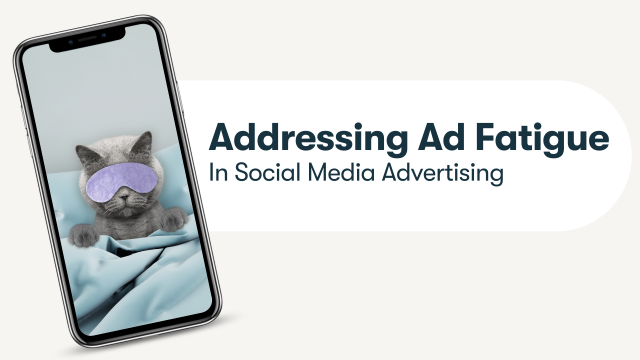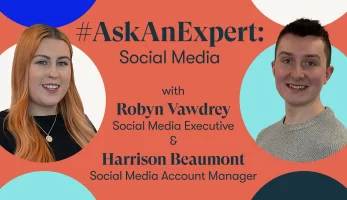What is ad fatigue in social media advertising?
Picture this: you’re scrolling through your favourite social media platform, and your feed seems inundated with repetitive, uninspiring ads. We’ve all been there right?
That’s ad fatigue in action. It’s the weariness that creeps in when users are bombarded with the same ads too frequently, leading to disinterest, indifference, and ultimately, disengagement.

Ad fatigue is not merely an inconvenience; it can have significant repercussions for businesses.
As users become disinterested, they are less likely to engage with the ad, meaning lowers click-through rates, reduced conversions (ultimately affecting the ROI of a campaign) an creating a negative brand perception which in turn could lead to frustration and unfollowing your business on social media.
Impact on audience engagement
Where attention is fleeting and competition is fierce, ad fatigue stands as a formidable adversary.
It’s not merely a passing inconvenience; it’s a phenomenon that can cast a shadow over various aspects of a brand’s online presence, from user engagement to brand perception.
Ad fatigue acts like a dampening agent on user engagement.
When users are continually exposed to the same advertisements, a sense of monotony sets in.
As this monotony deepens, users are less likely to interact with the ads.
Their interest wanes, and they become more adept at mentally tuning out the repetitive content.
As a result of this, businesses will see a reduction in likes, shares and comments on their ads, the ability to incite curiosity or spark conversation will diminish, and the connection between brand and customer will fade.
Click-through rates will also suffer a significant blow under the weight of ad fatigue.
A user who has seen an ad multiple times and found it uninteresting or redundant is less inclined to click on it.
Not addressing this issue will lead to a drop in CTR and therefore reduce the number of website visits and hinder the customer journey by failing to direct customers to landing/product pages.
Finally, conversions; the ultimate goal of many marketing efforts, becomes an elusive prize in the presence of ad fatigue.
As users become disenchanted with the repeated ads, their willingness to take the desired action dwindles, leading to fewer users sign up, purchase products, or subscribe to services, the conversion funnel experiences leakage, hampering revenue generation, and marketing efforts that led users down the conversion path lose their efficiency.
Recognising the signs of ad fatigue
It’s important for businesses to effectively monitor their ads and to quickly recognise when ad fatigue may be present.
To maintain a vibrant and engaged audience, it’s crucial to identify the signs of ad fatigue early on.
Here’s how you can recognize the tell-tale indicators:
1. Declining Engagement Metrics:
Reduced Likes, Shares, and Comments: If you notice a steady decline in user interactions with your ads, it could be a sign that your audience is becoming disengaged.
Diminished Click-Through Rates (CTR): A drop in CTR indicates that users are not finding your ads compelling enough to take action, possibly due to overexposure.
2. Increased Negative Feedback:
Higher Hide or Report Rates: If users are actively hiding your ads or reporting them as irrelevant or annoying, it’s a clear signal that your ads might be causing frustration.
Negative Comments: An increase in negative comments or feedback on your ads can suggest that users are becoming weary of the content.
3. Consistent Ad Placement:
Predictable Ad Placement: If users can predict when and where your ads will appear, they might tune them out, as the element of surprise diminishes.
4. Decreased Return on Investment (ROI):
Dwindling Conversions: A decline in conversions compared to previous periods may indicate that users are no longer responding to your ads effectively.
5. Frequency Overload:
High Ad Frequency: If the same ad is shown to the same user too frequently, it can lead to desensitization and fatigue. Keep an eye on the frequency of ad impressions per user.
6. Plateauing Metrics:
Stagnant Performance: If key metrics like engagement, CTR, and conversions have plateaued despite ongoing efforts, it might be a sign that your audience has grown tired of your ads.
7. Decreased Overall Reach:
Declining Reach: A diminishing reach could be a sign that your ads are not resonating with your target audience anymore.
8. Ad Burnout Across Platforms:
Similar Performance on Different Platforms: If you’re running the same ads across multiple social media platforms and noticing diminishing returns uniformly, it could indicate ad fatigue.
9. Negative Shift in Sentiment:
Change in User Sentiment: If the sentiment around your ads shifts from positive to neutral or negative, it’s an indicator that users are no longer finding value in your content.
10. Over-Reliance on Top-Performing Creatives:
Dependency on Specific Creatives: If you find that only a couple of your ad creatives are delivering results while others are languishing, it could suggest that users have grown weary of the overused content.
How to address ad fatigue?
Armed with the right strategies, businesses can reinvigorate their social media advertising efforts and keep their audience engaged and interested.
Use Different Visuals: Rotate through a variety of images, videos, and graphics to capture different aspects of your brand and products.
Leverage Carousel Ads: Showcase multiple products or features in a single ad, adding an element of intrigue and variety.
Frequency Capping: Set limits on how often a single user sees your ad to prevent overexposure and desensitization.
Test Different Frequencies: Experiment with different ad frequencies to find the sweet spot that maximizes engagement without causing fatigue.
Refine Targeting: Use data-driven insights to tailor your ads to specific segments of your audience, ensuring relevance and resonance.
Dynamic Ads: Implement dynamic ad strategies that personalize the content based on user behaviour and preferences.
Update Visuals: Regularly refresh ad visuals, whether it’s a change in colours, layouts, or design elements.
Evolve Messaging: Modify ad copy to introduce new angles or highlight different benefits of your products or services.
Experiment with Variations: Test different ad elements, such as headlines, images, or calls to action, to identify which combinations resonate the most with your audience.
Iterative Improvement: Continuously optimize your ads based on the insights gained from A/B tests.
Plan Ahead: Create a content calendar to ensure a steady stream of fresh and relevant content that prevents ad fatigue.
Timely Updates: Align your ads with current events, holidays, or industry trends to maintain relevance.
Monitor Comments and Feedback: Pay attention to user comments and messages to gauge sentiment and identify areas for improvement.
Adapt Based on Feedback: Use user suggestions and concerns to adjust your ad strategy and content.
Seasonal Campaigns: Launch themed campaigns or promotions that align with different seasons or events to keep the content exciting.
Product Highlights: Focus on specific products or services at different times to provide a fresh perspective.
Tell Stories: Craft ads that tell a narrative, sharing the journey, values, or behind-the-scenes aspects of your brand.
Connect on an Emotional Level: Evoking emotions through storytelling can create a deeper connection and break through ad fatigue.
Regular Analysis: Continuously track and analyse key performance metrics to identify trends and shifts in user behaviour.
Iterative Adaptation: Use data insights to refine your strategies and tactics over time.
By incorporating these strategies into your social media advertising approach, you can break the cycle of monotony, captivate your audience, and ensure that your brand remains a vibrant and engaging presence in the digital landscape.
Remember, the key is to evolve with your audience to maintain lasting connections and drive meaningful results.
Utilise data and analytics
Analytics and data is an incredibly powerful tool for businesses in many ways to aid it’s success.
By employing data and analytics as your guiding lights (such as Google Analytics or Hootsuite), you can navigate the complex terrain of ad fatigue.
Staying close to the performance of your campaign is key.
In order to make maximum use of the data you receive from your analytics tool, you need to establish your benchmarks, have historical data if possible so that you can compare and track trends, consider seasonality changes in your business and set actionable goals.
You can monitor your ads performance through data in multiple ways, such as:
- Keep a close eye on engagement metrics such as likes, shares, comments, click-through rates (CTR), and conversion rates.
- Monitor how ads perform on different platforms, placements, and devices to identify trends.
- Track how many times an individual user sees your ad. If this number becomes excessive, it’s a red flag for ad fatigue.
- Analyse the distribution of clicks across various ad elements (e.g., headlines, images, calls to action) to pinpoint what resonates most.
- Observe how ad performance changes over time. Sudden drops in engagement or CTR could indicate ad fatigue.
- Use analytics to understand which demographic groups engage most with your ads. Adjust targeting based on this insight.
- Determine if certain regions or countries respond better to specific ad content.
- Analyse user behaviour beyond the initial click to identify if they drop off at a particular point in the conversion funnel.
We can help you…
We have helped 100’s of small and medium sized businesses transform their social media advertising and take their businesses to the next level.
Take a look at just some of our success stories below:
Swinging café doors – see how they unlocked new new revenue streams and achieved 13,625 clicks from their Facebook ad
Black Point Perfumes – see how we helped Black Point Perfumes achieve a 230% ROAS in a highly-competitive market on Facebook
Power Tool Services – see how we worked with Power Tool Services to build the perfect Facebook ad campaigns and help them achieve £9,000 of revenue in just 2 weeks (that’s a 4,860% ROAS)!
Remember that this journey does not need to be a solitary one.
The experience of Add People and the lessons we have learned over the years from our triumphs and trials, serve as a guide to create your path forward.
Working with us will provide you with a first class service including, a dedicated Account Manager, expert level ad creation, access to the latest tools and services, frequent tweaks and optimisation, performance tracking and reporting, and most importantly, peace of mind that your campaigns and ads are in safe hands.
Together, we have the power to redefine success and leave ad fatigue in the rear-view mirror.




